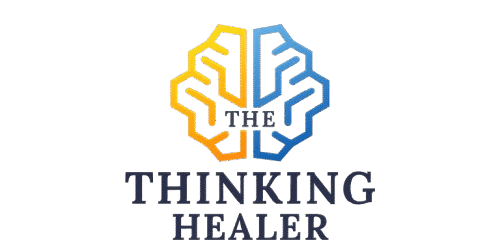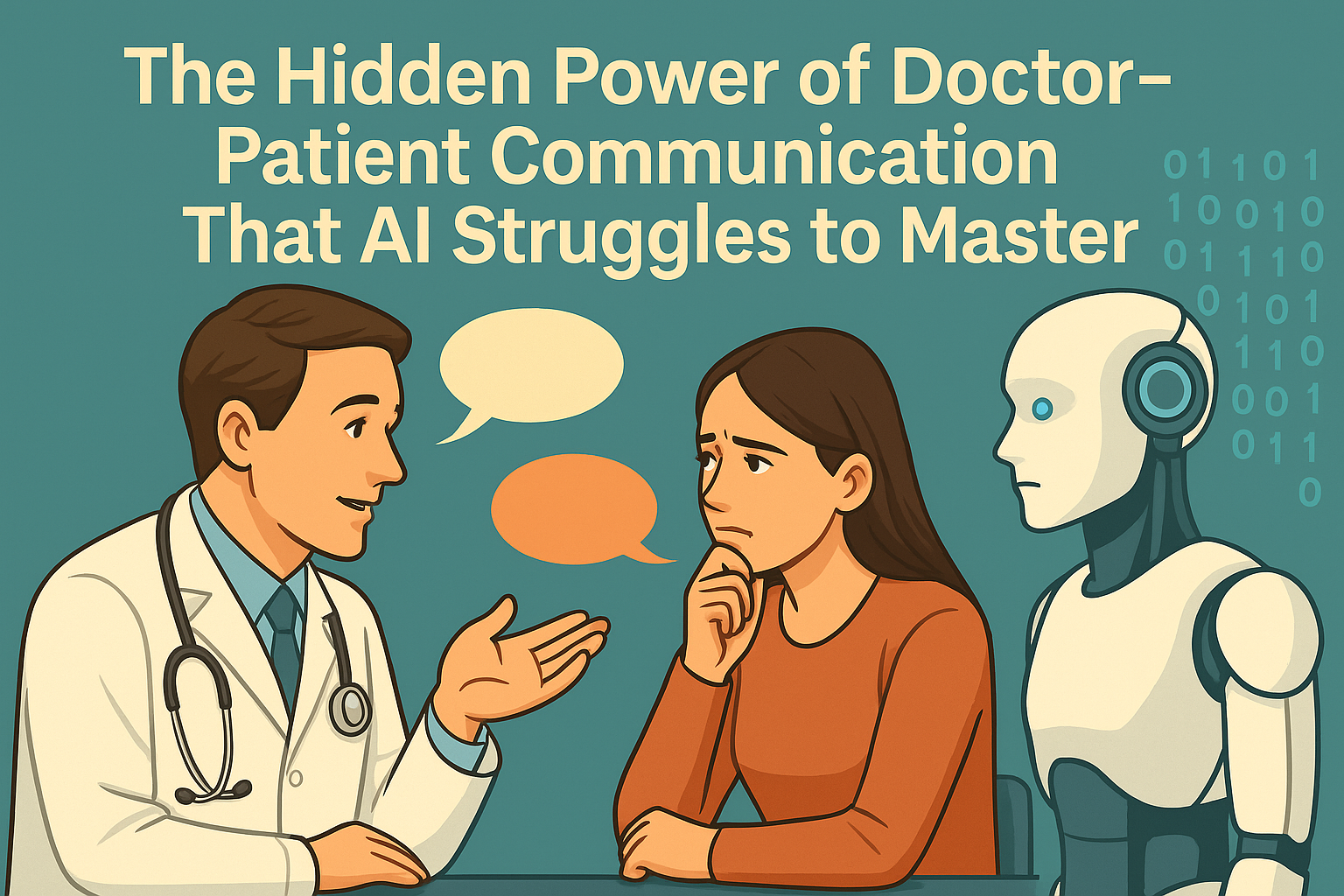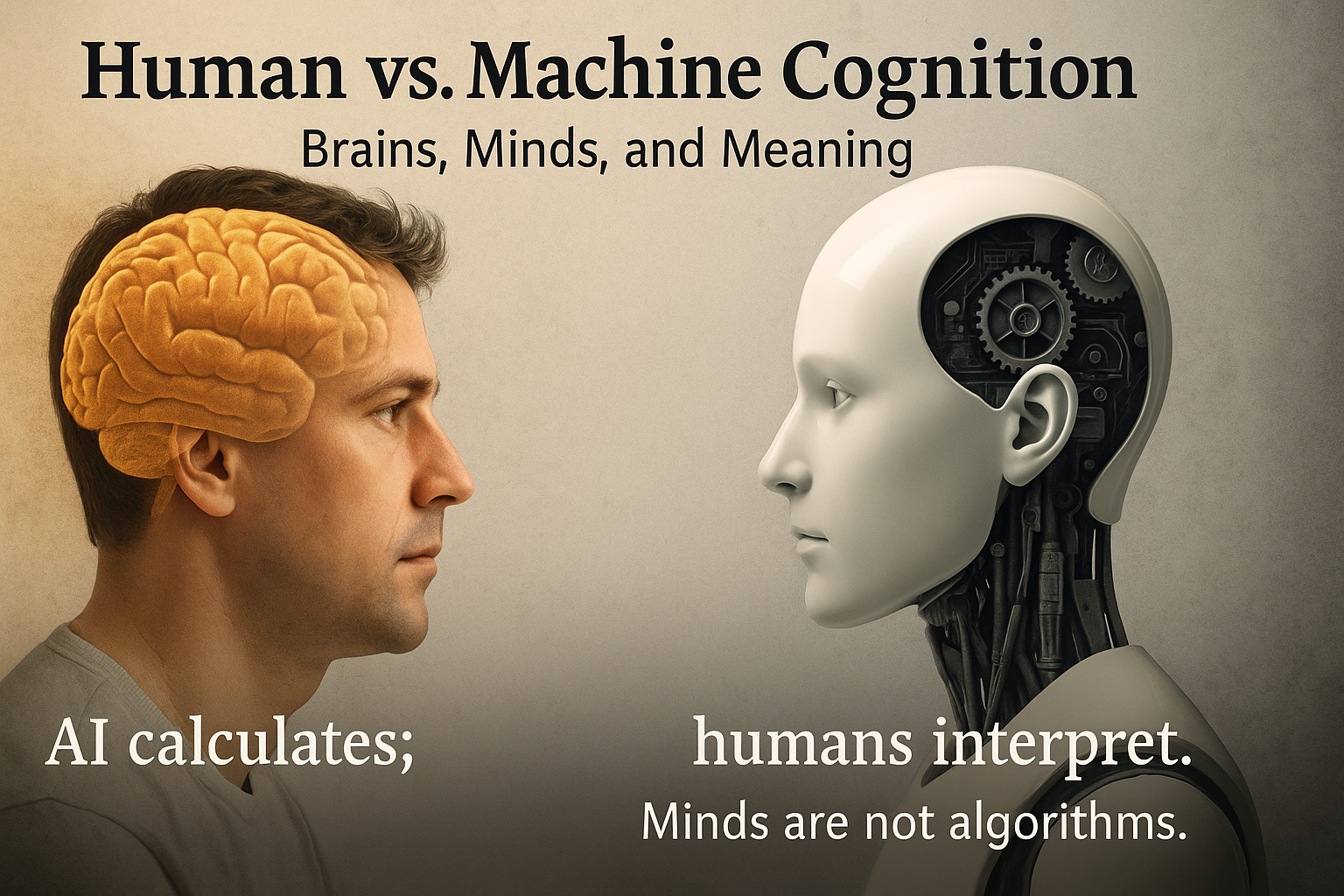“To say something is to do something.” — J.L. Austin
Artificial Intelligence (AI) is transforming medicine, excelling in diagnosing diseases, predicting risks, and analyzing patterns in vast datasets. Yet, despite these advances, AI struggles with a core element of medical practice: communication. Not just in parsing words, but in grasping what words do—how they convey emotion, build trust, or alter a patient’s reality. This document explores why AI falls short in capturing the nuanced, performative nature of doctor–patient dialogue, drawing on philosophy, real-world examples, and emerging research to propose how AI can evolve.
A Case Vignette: “It’s Just a Cough”
Mrs. K, a 38-year-old schoolteacher, visits an outpatient clinic complaining of “just a cough.” She mentions it casually, quickly shifting to discuss her son’s school admissions and home repairs. An AI-powered triage system, analysing her symptoms and vitals, labels her case as “URTI” (Upper Respiratory Tract Infection) and assigns a low-priority, 5-minute virtual consult.
The physician, however, insists on an in-person visit. Noticing Mrs. K’s hesitant tone, shallow breathing, and subtle anxiety—cues not captured in the AI’s data—the doctor orders a chest X-ray. The result reveals a left upper lobe mass, suggestive of lung carcinoma.
This case, inspired by real-world scenarios, underscores a critical gap: AI missed not just data, but the dialogue that revealed the patient’s underlying condition.
What AI Missed Was Not Just Data—But Dialogue
Mrs. K’s “just a cough” was more than a symptom description. It was a speech act—a complex blend of expression, minimisation, and an unspoken plea for reassurance. British philosopher J.L. Austin introduced the concept of speech acts, arguing that language is not merely a tool for conveying facts but a means of performing actions, such as promising, empathising, or altering social roles. In medicine, every doctor–patient conversation is rich with such acts, carrying emotional, cultural, and ethical weight.
AI processed Mrs. K’s words as data but failed to interpret what her words were doing—concealing fear, seeking trust, or signalling something deeper. This gap reflects a broader limitation in AI’s ability to navigate the human elements of medical communication.
Another Example: The Silent Symptom
Consider a second case: Mr. J, a 55-year-old man, reports “occasional chest pain” during a telehealth visit. The AI system, trained on symptom checklists, flags it as possible indigestion and recommends antacids. The physician, however, notices Mr. J’s reluctance to elaborate and his nervous laughter. Probing further, the doctor uncovers a family history of heart disease and orders an ECG, revealing early signs of coronary artery disease. Studies, such as a 2023 analysis in The Lancet Digital Health, show that AI triage systems misclassify up to 15% of urgent cases when relying solely on symptom data, often missing subtle cues like tone or hesitation that human clinicians detect.
Types of Speech Acts in Medical Dialogue
Austin’s speech act theory categorizes language into performative types, each serving a distinct function. In medical contexts, these include:
| Type | Example | Function |
| Assertives | “You have diabetes.” | States a clinical fact |
| Directives | “Take this medicine.” | Influences patient action |
| Commissives | “I’ll call you tomorrow.” | Commits to future action |
| Expressives | “I understand your fear.” | Conveys empathy or emotion |
| Declarations | “You are being admitted.” | Alters institutional or clinical status |
AI excels at assertives, delivering data-driven statements based on lab results or imaging. However, it struggles with:
-
- Expressives: Conveying empathy requires understanding emotional context, which AI approximates through sentiment analysis but cannot fully replicate.
-
- Declarations: Changing a patient’s status (e.g., admitting them) involves ethical and institutional judgment, often beyond AI’s scope.
-
- Directives: Issuing instructions like “Take this medicine” requires tailoring to cultural or psychological factors, which AI often overlooks.
For example, a 2024 study in Journal of Medical Internet Research found that AI chatbots failed to adapt recommendations to patients’ cultural beliefs in 20% of cases, leading to lower adherence compared to human providers.
Why AI Struggles with Language’s Function
AI, including advanced large language models (LLMs), is trained on structured inputs—vitals, symptoms, and text data. Yet, Mrs. K’s diagnosis hinged on the physician’s interpretation of unstructured cues: tone, hesitation, and cultural norms. These require what linguists call pragmatic competence—the ability to understand a speaker’s intention, emotional state, or unspoken fears. Similarly, Mr. J’s case relied on the doctor’s intuition about what was not said.
AI’s limitations stem from its reliance on pattern recognition rather than lived, relational understanding. It can mimic empathy (e.g., “I’m sorry you’re feeling this way”) but struggles to grasp the existential weight of a statement like “You have cancer.” This is because AI lacks the human experience of fear, trust, or moral responsibility—elements central to medical communication.
Counterargument: Can AI Improve?
Some argue that AI could overcome these limitations. Advances in affective computing, such as emotion recognition from voice or facial expressions, show promise. For instance, Google’s DeepMind has developed models that detect emotional cues in speech with 80% accuracy in controlled settings. Additionally, AI can augment human doctors by handling routine tasks, freeing them to focus on complex communication. However, even these advancements fall short of the nuanced, context-driven listening that human clinicians provide, particularly in high-stakes scenarios where cultural or emotional subtleties are critical.
Implications: Bridging the Gap
To address AI’s communication shortcomings, developers must go beyond data-driven models. Here are specific recommendations:
-
- Incorporate Discourse Ethics: Train AI to recognize the ethical dimensions of communication, such as respecting patient autonomy or addressing cultural sensitivities. For example, IBM’s Watson could integrate modules that flag when a patient’s tone suggests hesitation, prompting a human clinician’s review.
-
- Apply Speech Act Theory: Design AI to categorize patient statements as assertives, expressives, or directives, tailoring responses accordingly. A prototype at Stanford University uses natural language processing to identify expressives, improving patient satisfaction in telehealth.
-
- Enhance Contextual Reasoning: Use multimodal AI that combines text, voice, and visual cues to better interpret intent. For instance, integrating facial recognition with LLMs could help AI detect anxiety, as piloted in a 2025 trial by MIT’s Media Lab.
-
- Complement Human Clinicians: Deploy AI as a triage tool that flags cases requiring human intervention, as seen in systems like Babylon Health, which routes complex cases to doctors when communication cues are ambiguous.
These steps require collaboration between AI developers, linguists, ethicists, and clinicians to ensure AI supports, rather than replaces, the human element of medicine.
Conclusion: The Thinking Healer’s Takeaway
AI can diagnose, predict, and alert with remarkable accuracy. But it struggles to listen between the lines—to hear the fear behind “just a cough” or the hope in a hesitant question. Only humans, attuned to the philosophy of communication, can fully navigate the moral and relational acts of medicine.
As Austin reminds us, “Saying something is not merely to state a fact, but to do something.” Medicine is as much about doing—building trust, offering hope, transforming lives—as it is about knowing. AI can assist, but the healing power of being truly heard remains, for now, a uniquely human gift.




Dr Narayan Pandharinath survase
Great insights ,Thoughtful Delibration ,need of time in today’s misty scnerio useful for patient ,doctor ,anxious relatives and overall all the society .
Heartily congratulations and best luck Abhijeet for future journey …..